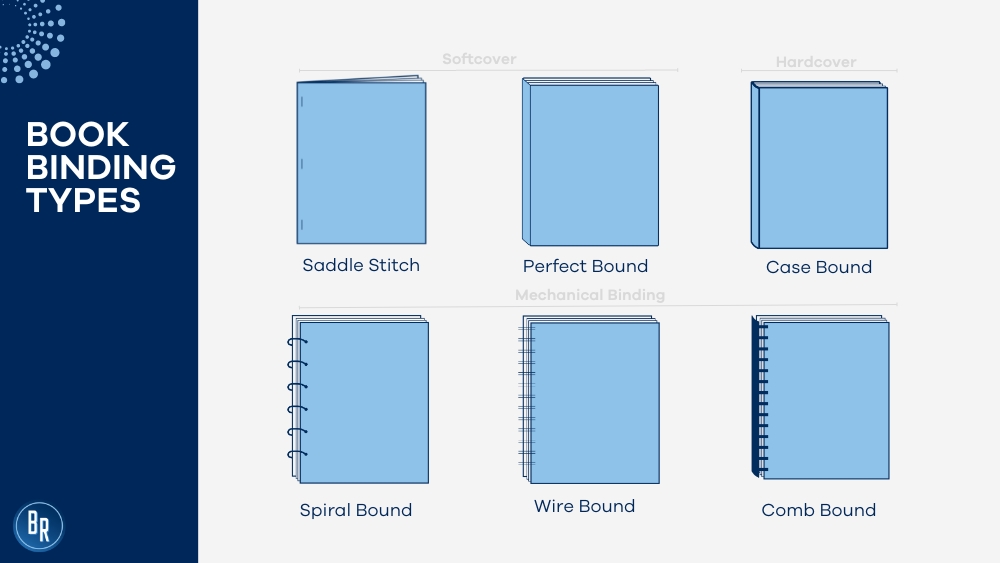Book Binding Types: A Publishers Guide
Book publishing is a long and creative process. The strategic decisions you make as a publisher don’t end when the contents of the book are finalized. Before books make it into readers’ hands, they’re printed, bound, and distributed by book printers like us at BR Printers. The printing process is an important step for publishers and authors alike because it determines the look and feel of the final product.
Binding type can be a major creative decision which is why we have identified and differentiated the most common types of book binding so you can choose the best type for your book.
Types of Book Binding
Readers expect publishers and authors to deliver an easy and enjoyable reading experience. A part of this experience is the physical attributes of a book (paper type, size, binding, etc.). When it comes time for publishers to partner with a book printer and choose a binding type, there are many factors to consider such as book length, purpose, and budget.
Books can be hardcover or softcover and they can also be mechanically bound. Mechanical binding styles are created for books that need to be opened flat, such as cookbooks or school exercise books.
Want to share the book binding types with others? Download and share this document!
Saddle Stitch
Saddle stitch binding, a binding type used to create softcover books, is a method where folded book pages are stacked and the spine of the booklet is stapled together. Shorter books such as booklets, magazines, programs, brochures, and catalogs typically use the saddle stitch binding method.
Pros
- Simple
- Inexpensive
- Books lay flat
- Quick
- No glue necessary
- Easy to ship
Cons
- Not durable
- Not meant for lots of pages
Perfect Bound
Perfect binding is the popular book binding choice for a softcover book. Perfect binding is a process where pages are glued to the book cover with a high quality flexible adhesive. When authors and publishers are printing trade books, smaller educational books, and high end marketing materials they commonly choose to print perfect bound books.
Pros
- Inexpensive (in comparison to a hardcover book)
- Quick
- Durable
- Easy to ship
- Can bind lots of pages
Cons
- Books do not lay flat
- Less durable than a hardcover book
Spiral Bound
Spiral binding, also known as coil binding, is a type of mechanical binding. For this book binding type, one spiraling wire is inserted into holes punched in the book pages. Spiral binding is commonly used for calendars, cookbooks, workbooks, manuals, reports, and brochures because spiral bound books can hold a high volume of pages and fold completely open.
Pros
- Inexpensive
- Can be folded and opened completely
- Durable
- Can hold lots of pages
- Variety of page sizes possible
Cons
- Title cannot be printed on the spine (this is an issue at bookstores)
- Pages cannot be easily added or removed
Comb Bound
Comb binding or plastic binding is a mechanical binding type where a plastic spine and rings hold books together once they’re hole punched. Many document-based books use this method: reports, handbooks, and educational books.
Pros
- Inexpensive
- Title can be printed on the spine
- Can hold lots of pages
- Pages can easily be added or removed
Cons
- Can’t be folded completely
- Little variety of page sizes possible
- Not durable
Wire Bound
Wire bound is a mechanical binding type where multiple flexible wires are inserted into holes punched into book pages. This binding style is used for many document-based books such as school exercise books, commercial documents, and calendars.
Pros
- Can be folded and opened completely
- Durable
- Variety of page sizes possible
- Professional look
Cons
- Expensive
- Title cannot be printed on the spine (this is an issue at bookstores)
- Pages cannot be easily added or removed
Case Bound
Case bound books are commonly known as hardcover books. Case binding is a process where book pages are folded and organized into sections. Those sections are glued or sewn together, then endpapers are glued to the hardcover. Case bound books are common for larger trade books and education books.
Pros
- Can be folded out completely
- Durable
- Can bind lots of pages
- Professional look
- High value
Cons
- Expensive
- Difficult to ship
- Slow
Bring Your Books to Life, Partner with BR Printers
Understanding the binding types is a tool all publishers should have. A book’s binding can add value and encourage your audience to pull it off the shelf more often. Maybe they’ll even keep it on their coffee table or kitchen counter.
With years of book printing experience under our belt, the BR Printers team is ready to help you bring your book to life. Our short, mid-range, and long run book production capabilities provide the quality and flexibility you need to efficiently and cost-effectively reach your reading audience. Partner with BR, contact us today.
